A Detailed Report on Crop Nutrition in Cotton: Fertilizers & Rotation
VerifiedAdded on 2023/01/23
|6
|1017
|77
Report
AI Summary
This report provides a comprehensive overview of crop nutrition, specifically focusing on cotton. It explores the critical role of nitrogen in cotton growth and the implications of both inadequate and excessive fertilization. The report delves into the use of synthetic fertilizers, detailing the timing and methods of application to optimize nitrogen uptake, and discusses the benefits of multi-nutrient fertilizers. Furthermore, it examines the alternative approach of using legume rotations to enhance soil nitrogen content, highlighting the practice of alternating cotton with legume or cereal crops. The report concludes by emphasizing the importance of balancing synthetic and organic methods to ensure healthy crop yields while minimizing environmental impact.
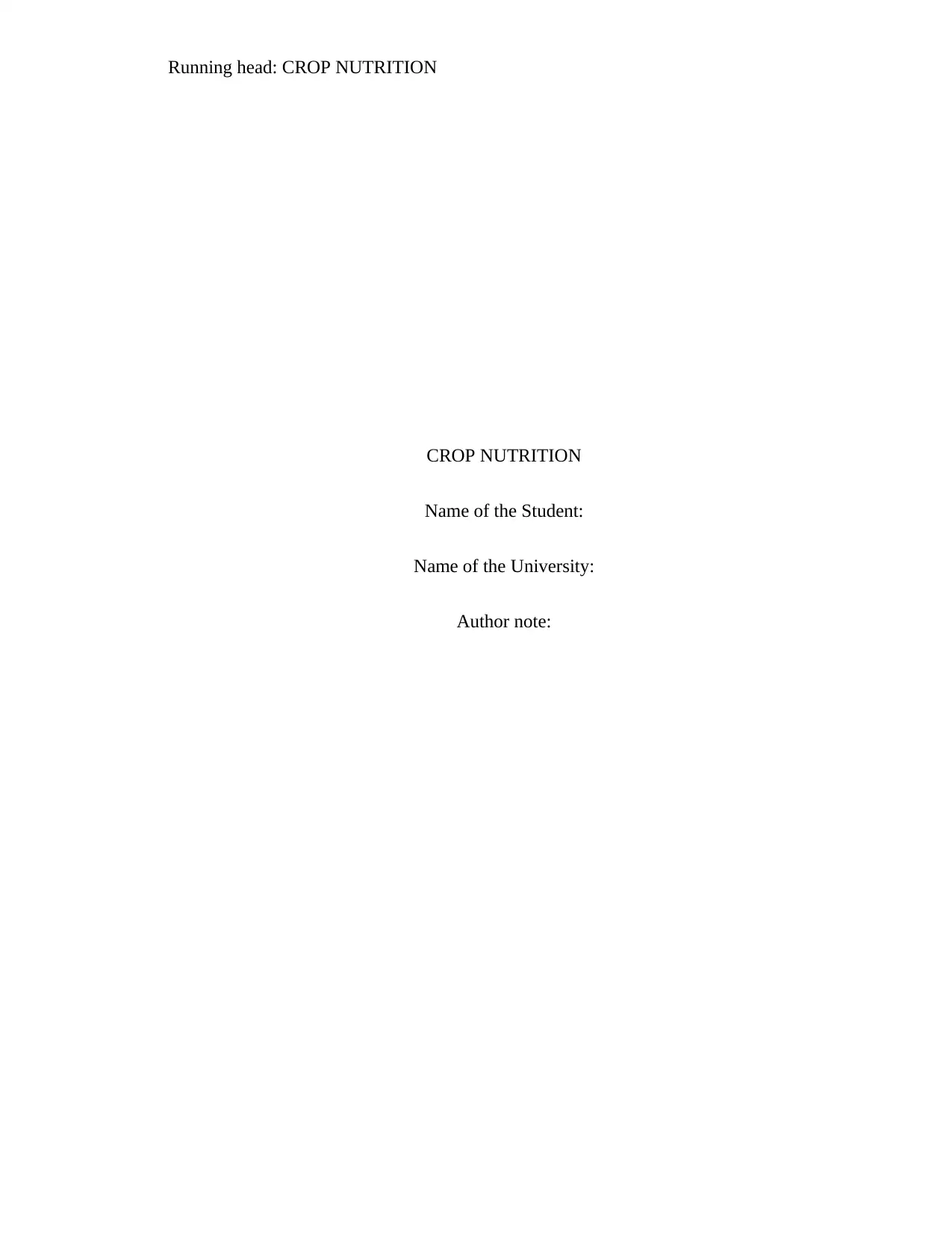
Running head: CROP NUTRITION
CROP NUTRITION
Name of the Student:
Name of the University:
Author note:
CROP NUTRITION
Name of the Student:
Name of the University:
Author note:
Paraphrase This Document
Need a fresh take? Get an instant paraphrase of this document with our AI Paraphraser
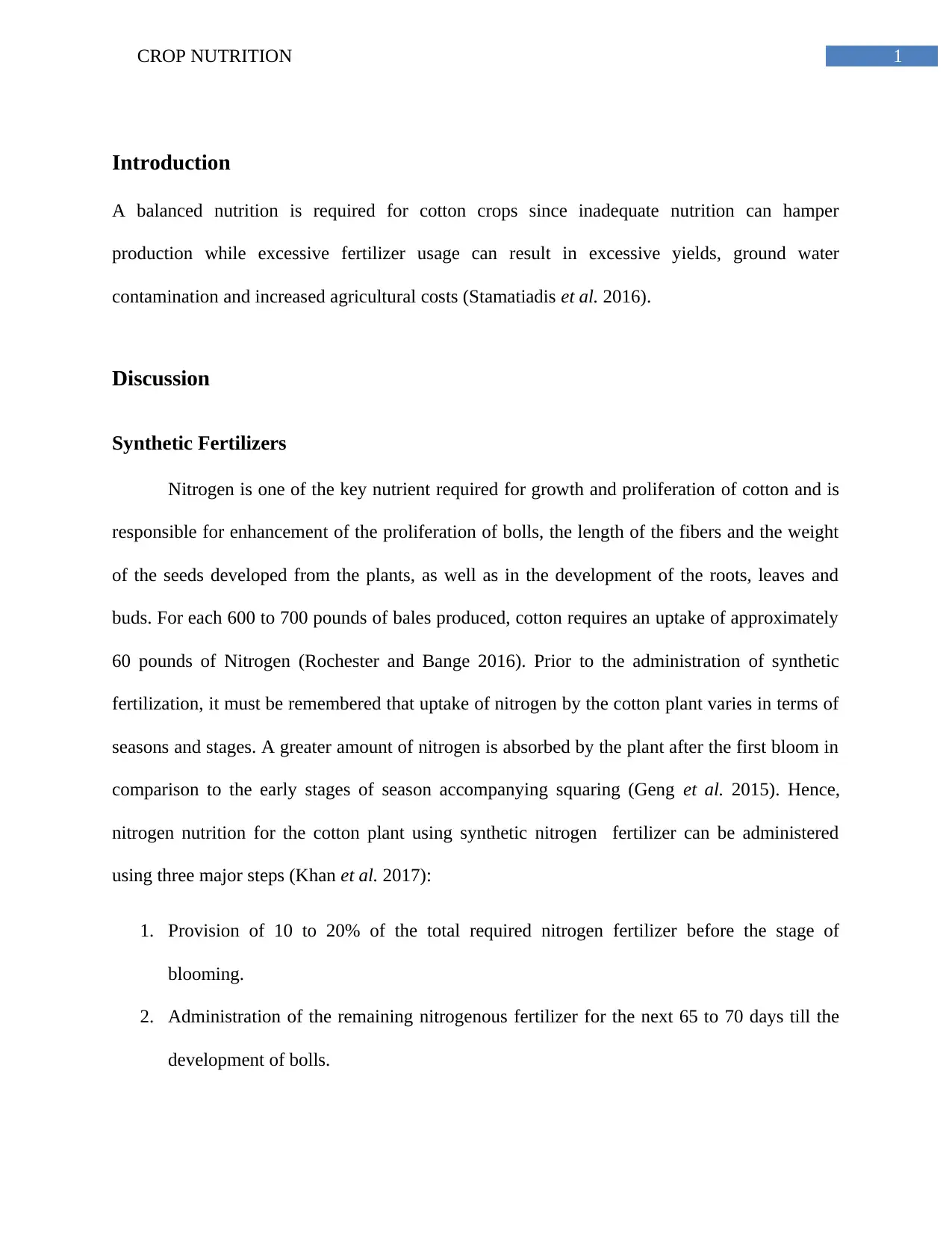
1CROP NUTRITION
Introduction
A balanced nutrition is required for cotton crops since inadequate nutrition can hamper
production while excessive fertilizer usage can result in excessive yields, ground water
contamination and increased agricultural costs (Stamatiadis et al. 2016).
Discussion
Synthetic Fertilizers
Nitrogen is one of the key nutrient required for growth and proliferation of cotton and is
responsible for enhancement of the proliferation of bolls, the length of the fibers and the weight
of the seeds developed from the plants, as well as in the development of the roots, leaves and
buds. For each 600 to 700 pounds of bales produced, cotton requires an uptake of approximately
60 pounds of Nitrogen (Rochester and Bange 2016). Prior to the administration of synthetic
fertilization, it must be remembered that uptake of nitrogen by the cotton plant varies in terms of
seasons and stages. A greater amount of nitrogen is absorbed by the plant after the first bloom in
comparison to the early stages of season accompanying squaring (Geng et al. 2015). Hence,
nitrogen nutrition for the cotton plant using synthetic nitrogen fertilizer can be administered
using three major steps (Khan et al. 2017):
1. Provision of 10 to 20% of the total required nitrogen fertilizer before the stage of
blooming.
2. Administration of the remaining nitrogenous fertilizer for the next 65 to 70 days till the
development of bolls.
Introduction
A balanced nutrition is required for cotton crops since inadequate nutrition can hamper
production while excessive fertilizer usage can result in excessive yields, ground water
contamination and increased agricultural costs (Stamatiadis et al. 2016).
Discussion
Synthetic Fertilizers
Nitrogen is one of the key nutrient required for growth and proliferation of cotton and is
responsible for enhancement of the proliferation of bolls, the length of the fibers and the weight
of the seeds developed from the plants, as well as in the development of the roots, leaves and
buds. For each 600 to 700 pounds of bales produced, cotton requires an uptake of approximately
60 pounds of Nitrogen (Rochester and Bange 2016). Prior to the administration of synthetic
fertilization, it must be remembered that uptake of nitrogen by the cotton plant varies in terms of
seasons and stages. A greater amount of nitrogen is absorbed by the plant after the first bloom in
comparison to the early stages of season accompanying squaring (Geng et al. 2015). Hence,
nitrogen nutrition for the cotton plant using synthetic nitrogen fertilizer can be administered
using three major steps (Khan et al. 2017):
1. Provision of 10 to 20% of the total required nitrogen fertilizer before the stage of
blooming.
2. Administration of the remaining nitrogenous fertilizer for the next 65 to 70 days till the
development of bolls.
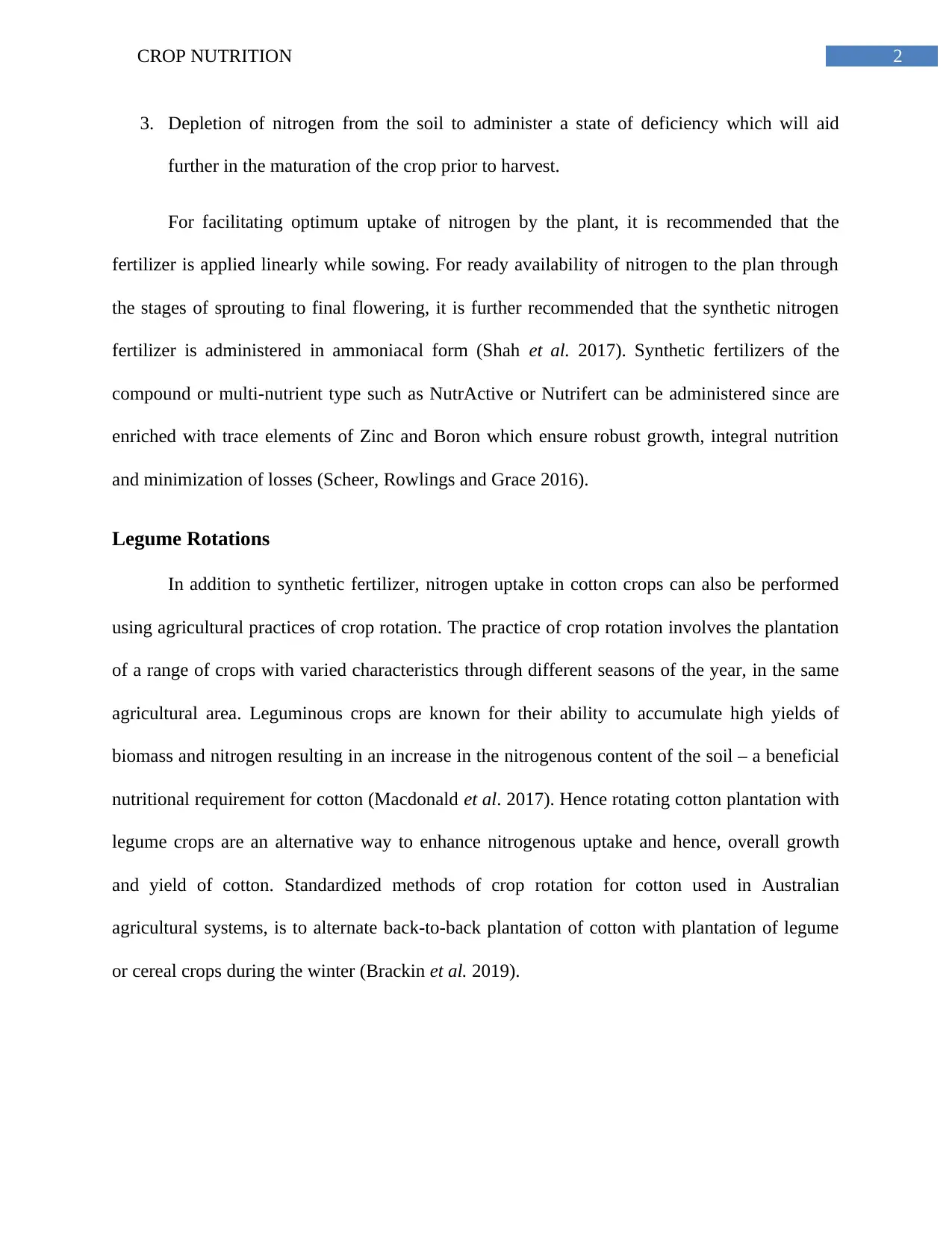
2CROP NUTRITION
3. Depletion of nitrogen from the soil to administer a state of deficiency which will aid
further in the maturation of the crop prior to harvest.
For facilitating optimum uptake of nitrogen by the plant, it is recommended that the
fertilizer is applied linearly while sowing. For ready availability of nitrogen to the plan through
the stages of sprouting to final flowering, it is further recommended that the synthetic nitrogen
fertilizer is administered in ammoniacal form (Shah et al. 2017). Synthetic fertilizers of the
compound or multi-nutrient type such as NutrActive or Nutrifert can be administered since are
enriched with trace elements of Zinc and Boron which ensure robust growth, integral nutrition
and minimization of losses (Scheer, Rowlings and Grace 2016).
Legume Rotations
In addition to synthetic fertilizer, nitrogen uptake in cotton crops can also be performed
using agricultural practices of crop rotation. The practice of crop rotation involves the plantation
of a range of crops with varied characteristics through different seasons of the year, in the same
agricultural area. Leguminous crops are known for their ability to accumulate high yields of
biomass and nitrogen resulting in an increase in the nitrogenous content of the soil – a beneficial
nutritional requirement for cotton (Macdonald et al. 2017). Hence rotating cotton plantation with
legume crops are an alternative way to enhance nitrogenous uptake and hence, overall growth
and yield of cotton. Standardized methods of crop rotation for cotton used in Australian
agricultural systems, is to alternate back-to-back plantation of cotton with plantation of legume
or cereal crops during the winter (Brackin et al. 2019).
3. Depletion of nitrogen from the soil to administer a state of deficiency which will aid
further in the maturation of the crop prior to harvest.
For facilitating optimum uptake of nitrogen by the plant, it is recommended that the
fertilizer is applied linearly while sowing. For ready availability of nitrogen to the plan through
the stages of sprouting to final flowering, it is further recommended that the synthetic nitrogen
fertilizer is administered in ammoniacal form (Shah et al. 2017). Synthetic fertilizers of the
compound or multi-nutrient type such as NutrActive or Nutrifert can be administered since are
enriched with trace elements of Zinc and Boron which ensure robust growth, integral nutrition
and minimization of losses (Scheer, Rowlings and Grace 2016).
Legume Rotations
In addition to synthetic fertilizer, nitrogen uptake in cotton crops can also be performed
using agricultural practices of crop rotation. The practice of crop rotation involves the plantation
of a range of crops with varied characteristics through different seasons of the year, in the same
agricultural area. Leguminous crops are known for their ability to accumulate high yields of
biomass and nitrogen resulting in an increase in the nitrogenous content of the soil – a beneficial
nutritional requirement for cotton (Macdonald et al. 2017). Hence rotating cotton plantation with
legume crops are an alternative way to enhance nitrogenous uptake and hence, overall growth
and yield of cotton. Standardized methods of crop rotation for cotton used in Australian
agricultural systems, is to alternate back-to-back plantation of cotton with plantation of legume
or cereal crops during the winter (Brackin et al. 2019).
⊘ This is a preview!⊘
Do you want full access?
Subscribe today to unlock all pages.

Trusted by 1+ million students worldwide
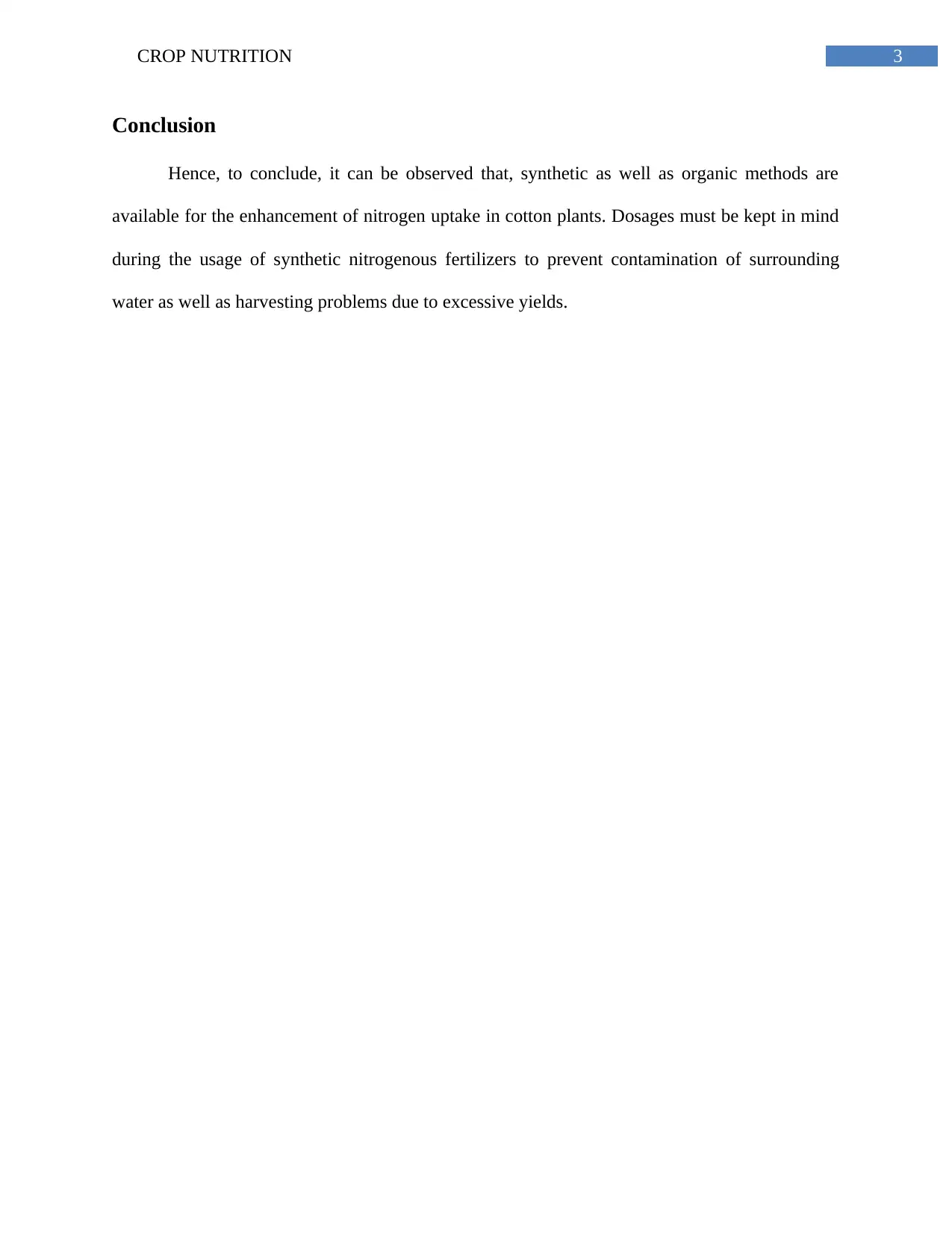
3CROP NUTRITION
Conclusion
Hence, to conclude, it can be observed that, synthetic as well as organic methods are
available for the enhancement of nitrogen uptake in cotton plants. Dosages must be kept in mind
during the usage of synthetic nitrogenous fertilizers to prevent contamination of surrounding
water as well as harvesting problems due to excessive yields.
Conclusion
Hence, to conclude, it can be observed that, synthetic as well as organic methods are
available for the enhancement of nitrogen uptake in cotton plants. Dosages must be kept in mind
during the usage of synthetic nitrogenous fertilizers to prevent contamination of surrounding
water as well as harvesting problems due to excessive yields.
Paraphrase This Document
Need a fresh take? Get an instant paraphrase of this document with our AI Paraphraser
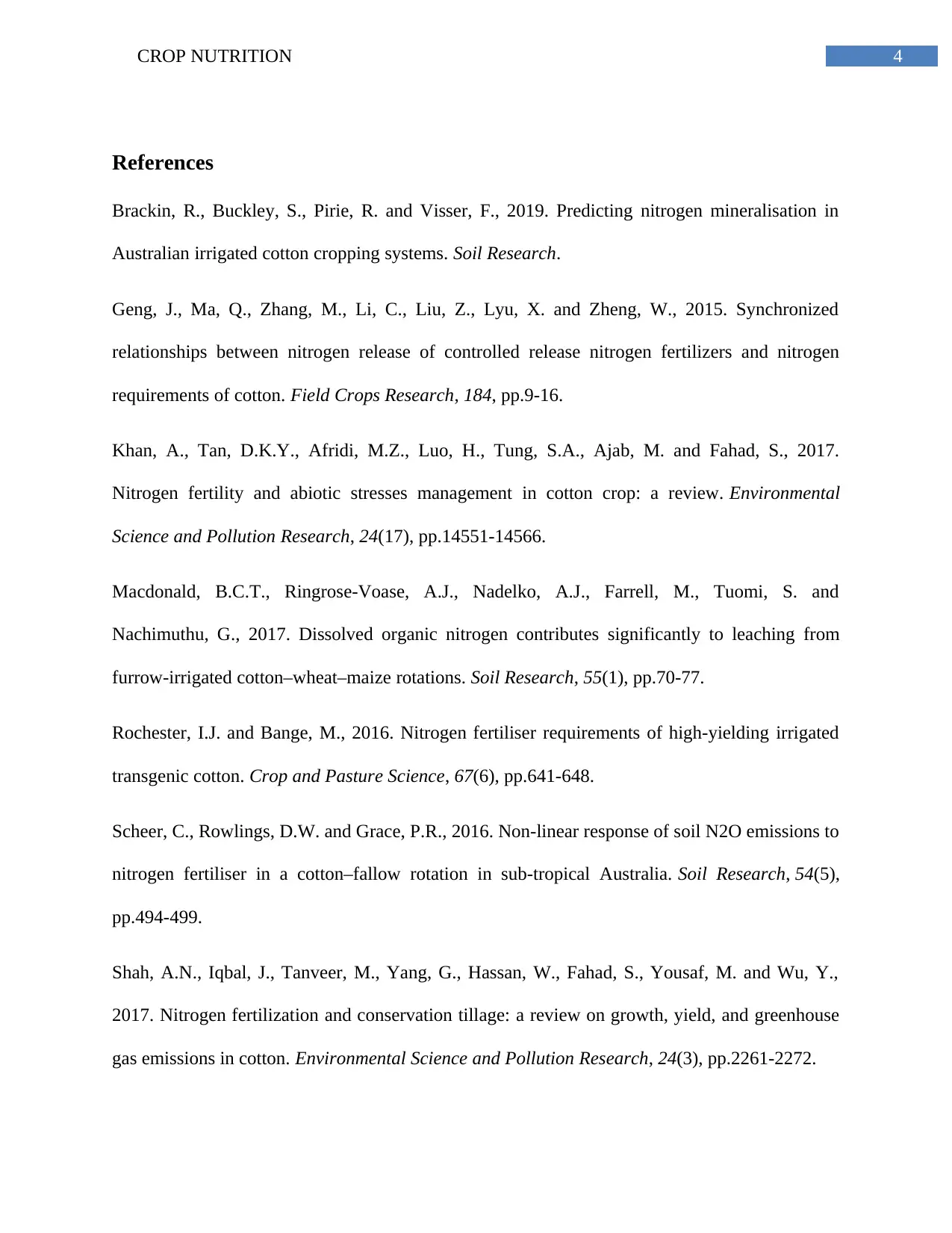
4CROP NUTRITION
References
Brackin, R., Buckley, S., Pirie, R. and Visser, F., 2019. Predicting nitrogen mineralisation in
Australian irrigated cotton cropping systems. Soil Research.
Geng, J., Ma, Q., Zhang, M., Li, C., Liu, Z., Lyu, X. and Zheng, W., 2015. Synchronized
relationships between nitrogen release of controlled release nitrogen fertilizers and nitrogen
requirements of cotton. Field Crops Research, 184, pp.9-16.
Khan, A., Tan, D.K.Y., Afridi, M.Z., Luo, H., Tung, S.A., Ajab, M. and Fahad, S., 2017.
Nitrogen fertility and abiotic stresses management in cotton crop: a review. Environmental
Science and Pollution Research, 24(17), pp.14551-14566.
Macdonald, B.C.T., Ringrose-Voase, A.J., Nadelko, A.J., Farrell, M., Tuomi, S. and
Nachimuthu, G., 2017. Dissolved organic nitrogen contributes significantly to leaching from
furrow-irrigated cotton–wheat–maize rotations. Soil Research, 55(1), pp.70-77.
Rochester, I.J. and Bange, M., 2016. Nitrogen fertiliser requirements of high-yielding irrigated
transgenic cotton. Crop and Pasture Science, 67(6), pp.641-648.
Scheer, C., Rowlings, D.W. and Grace, P.R., 2016. Non-linear response of soil N2O emissions to
nitrogen fertiliser in a cotton–fallow rotation in sub-tropical Australia. Soil Research, 54(5),
pp.494-499.
Shah, A.N., Iqbal, J., Tanveer, M., Yang, G., Hassan, W., Fahad, S., Yousaf, M. and Wu, Y.,
2017. Nitrogen fertilization and conservation tillage: a review on growth, yield, and greenhouse
gas emissions in cotton. Environmental Science and Pollution Research, 24(3), pp.2261-2272.
References
Brackin, R., Buckley, S., Pirie, R. and Visser, F., 2019. Predicting nitrogen mineralisation in
Australian irrigated cotton cropping systems. Soil Research.
Geng, J., Ma, Q., Zhang, M., Li, C., Liu, Z., Lyu, X. and Zheng, W., 2015. Synchronized
relationships between nitrogen release of controlled release nitrogen fertilizers and nitrogen
requirements of cotton. Field Crops Research, 184, pp.9-16.
Khan, A., Tan, D.K.Y., Afridi, M.Z., Luo, H., Tung, S.A., Ajab, M. and Fahad, S., 2017.
Nitrogen fertility and abiotic stresses management in cotton crop: a review. Environmental
Science and Pollution Research, 24(17), pp.14551-14566.
Macdonald, B.C.T., Ringrose-Voase, A.J., Nadelko, A.J., Farrell, M., Tuomi, S. and
Nachimuthu, G., 2017. Dissolved organic nitrogen contributes significantly to leaching from
furrow-irrigated cotton–wheat–maize rotations. Soil Research, 55(1), pp.70-77.
Rochester, I.J. and Bange, M., 2016. Nitrogen fertiliser requirements of high-yielding irrigated
transgenic cotton. Crop and Pasture Science, 67(6), pp.641-648.
Scheer, C., Rowlings, D.W. and Grace, P.R., 2016. Non-linear response of soil N2O emissions to
nitrogen fertiliser in a cotton–fallow rotation in sub-tropical Australia. Soil Research, 54(5),
pp.494-499.
Shah, A.N., Iqbal, J., Tanveer, M., Yang, G., Hassan, W., Fahad, S., Yousaf, M. and Wu, Y.,
2017. Nitrogen fertilization and conservation tillage: a review on growth, yield, and greenhouse
gas emissions in cotton. Environmental Science and Pollution Research, 24(3), pp.2261-2272.
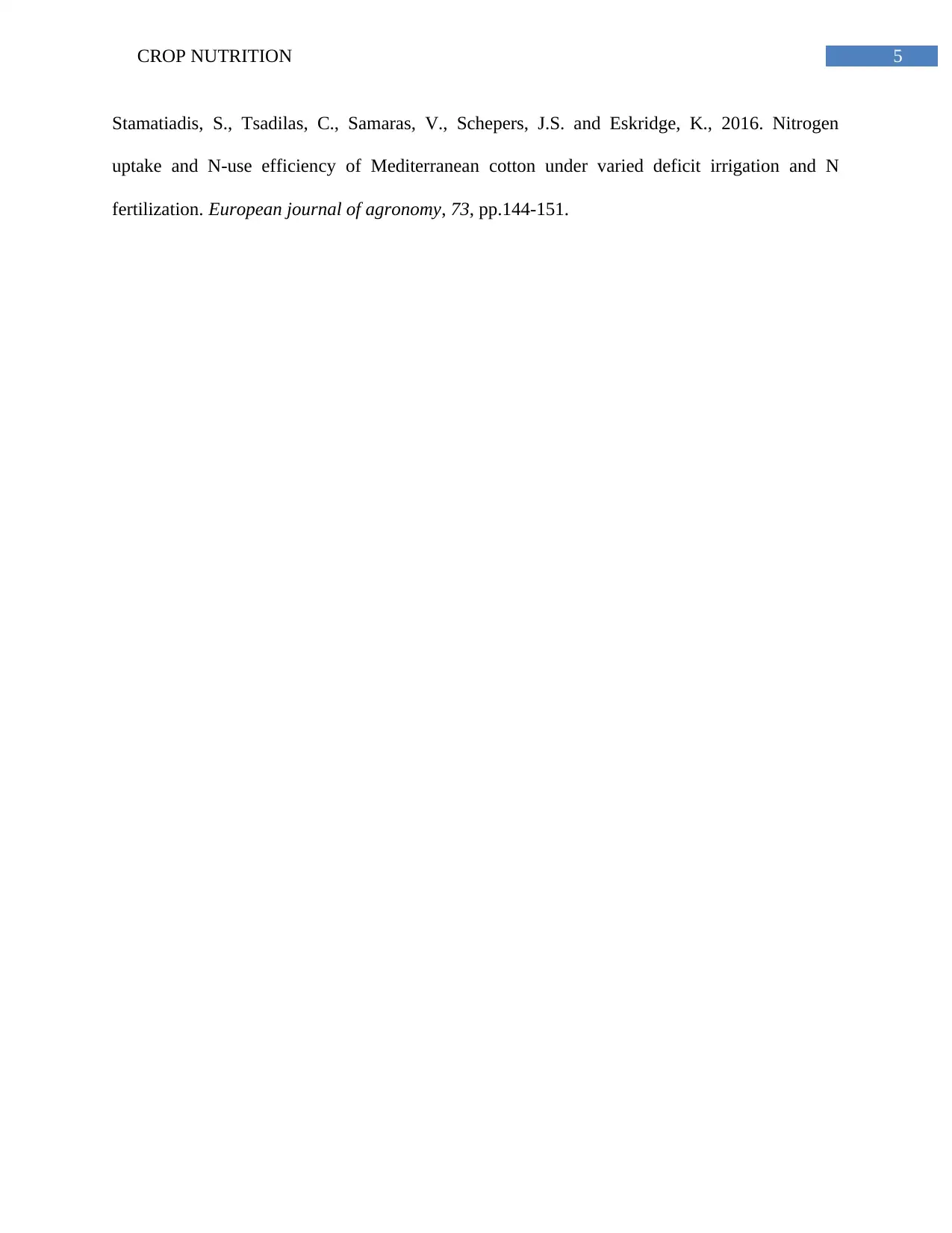
5CROP NUTRITION
Stamatiadis, S., Tsadilas, C., Samaras, V., Schepers, J.S. and Eskridge, K., 2016. Nitrogen
uptake and N-use efficiency of Mediterranean cotton under varied deficit irrigation and N
fertilization. European journal of agronomy, 73, pp.144-151.
Stamatiadis, S., Tsadilas, C., Samaras, V., Schepers, J.S. and Eskridge, K., 2016. Nitrogen
uptake and N-use efficiency of Mediterranean cotton under varied deficit irrigation and N
fertilization. European journal of agronomy, 73, pp.144-151.
⊘ This is a preview!⊘
Do you want full access?
Subscribe today to unlock all pages.

Trusted by 1+ million students worldwide
1 out of 6
Your All-in-One AI-Powered Toolkit for Academic Success.
+13062052269
info@desklib.com
Available 24*7 on WhatsApp / Email
![[object Object]](/_next/static/media/star-bottom.7253800d.svg)
Unlock your academic potential
Copyright © 2020–2025 A2Z Services. All Rights Reserved. Developed and managed by ZUCOL.

